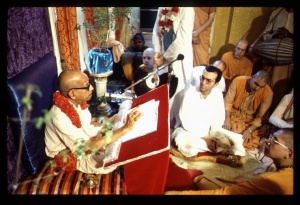SB 1.4.7 (1962): Difference between revisions
(Created page with '<div style="float:left">'''Goto SB 1.4.7 Current Edition'''</div> <div style="float:right">[[File:Go-previous.png|link=SB 1962 Fourth Chapter - Appearance of Sri Nar…') |
(Vanibot #0020: VersionCompareLinker - added a link to the Version Compare feature) |
||
| Line 1: | Line 1: | ||
<div style="float:left">'''[[SB | [[Category:Srimad-Bhagavatam (1962-1965) - Canto 01 Chapter 04|s07]] | ||
<div style="float:right">[[File:Go-previous.png|link=SB 1962 | <div style="float:left">[[File:Go-previous.png|link=SB (1962) Fourth Chapter - Appearance of Sri Narada]] '''[[SB (1962) Fourth Chapter - Appearance of Sri Narada]]'''</div> | ||
<div style="float:right">[[File:Go-previous.png|link=SB 1.4.6 (1962)]] '''[[SB 1.4.6 (1962)]] - [[SB 1.4.8 (1962)]]''' [[File:Go-next.png|link=SB 1.4.8 (1962)]]</div> | |||
{{CompareVersions|SB|1.4.7|SB 1962|SB 1972-77}} | |||
{{RandomImage}} | {{RandomImage}} | ||
| Line 6: | Line 8: | ||
==== TEXT No. 7 ==== | ==== TEXT No. 7 ==== | ||
<div class="SB65verse"> | |||
Katham ba pandavayasya rajrsher munina saha | |||
Sambadah samabhut tata yatra esha satwati shrutih. | |||
</div> | |||
==== ENGLISH SYNONYMS ==== | ==== ENGLISH SYNONYMS ==== | ||
<div class="synonyms"> | |||
<div | |||
Katham—how it is, ba—also, pandavayasya—of the descendant of Pandu (Parikshit), rajarshe—of the King who was a sage, munina—with the Muni, saha—along, sambadah—discussion, samabhut—took place, tata—darling, yatra—where upon, esha—like this, satwati—transcendental, shrutih—essence of the Vedas. | Katham—how it is, ba—also, pandavayasya—of the descendant of Pandu (Parikshit), rajarshe—of the King who was a sage, munina—with the Muni, saha—along, sambadah—discussion, samabhut—took place, tata—darling, yatra—where upon, esha—like this, satwati—transcendental, shrutih—essence of the Vedas. | ||
</div> | </div> | ||
| Line 22: | Line 23: | ||
==== TRANSLATION ==== | ==== TRANSLATION ==== | ||
<div class="translation"> | |||
<div | |||
How it so happened that King Parikshit met the great sage and thus the great transcendental essence of Vedas (Bhagwatam) was possible to be sung by Him. | How it so happened that King Parikshit met the great sage and thus the great transcendental essence of Vedas (Bhagwatam) was possible to be sung by Him. | ||
</div> | </div> | ||
| Line 30: | Line 30: | ||
==== PURPORT ==== | ==== PURPORT ==== | ||
<div class="purport"> | |||
<div | |||
Srimad Bhagwatam is stated here as the essence of the Vedas. It is not an imaginary story as it is sometimes remarked by unauthorised men. It is also called Sukasamita or the Vedic hymn spoken by Sri Sukdeva Goswami the great liberated sage. | Srimad Bhagwatam is stated here as the essence of the Vedas. It is not an imaginary story as it is sometimes remarked by unauthorised men. It is also called Sukasamita or the Vedic hymn spoken by Sri Sukdeva Goswami the great liberated sage. | ||
</div> | </div> | ||
<div style="float:left"> | <div style="float:left">'''[[SB 1.4.7|(Compare SB 1.4.7 Current Edition)]]'''</div> | ||
<div style="float:right">'''[[SB 1.4.8 (1962)]]'''[[File:Go-next.png|link=SB 1.4.8 (1962)]]</div> | <div style="float:right">[[File:Go-previous.png|link=SB 1.4.6 (1962)]] '''[[SB 1.4.6 (1962)]] - [[SB 1.4.8 (1962)]]''' [[File:Go-next.png|link=SB 1.4.8 (1962)]]</div> | ||
__NOTOC__ | __NOTOC__ | ||
__NOEDITSECTION__ | |||
Latest revision as of 11:15, 25 May 2020

A.C. Bhaktivedanta Swami Prabhupada
TEXT No. 7
Katham ba pandavayasya rajrsher munina saha Sambadah samabhut tata yatra esha satwati shrutih.
ENGLISH SYNONYMS
Katham—how it is, ba—also, pandavayasya—of the descendant of Pandu (Parikshit), rajarshe—of the King who was a sage, munina—with the Muni, saha—along, sambadah—discussion, samabhut—took place, tata—darling, yatra—where upon, esha—like this, satwati—transcendental, shrutih—essence of the Vedas.
TRANSLATION
How it so happened that King Parikshit met the great sage and thus the great transcendental essence of Vedas (Bhagwatam) was possible to be sung by Him.
PURPORT
Srimad Bhagwatam is stated here as the essence of the Vedas. It is not an imaginary story as it is sometimes remarked by unauthorised men. It is also called Sukasamita or the Vedic hymn spoken by Sri Sukdeva Goswami the great liberated sage.